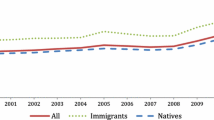Abstract
An exploration of inequality at the intersection of race, gender, and nationality offers a means to explore how complex economic and social forces combine to shape women’s outcomes in ways that differ from men’s. Women’s responsibility for care work and other forms of unpaid labor inhibits labor force participation, and in some cases, redounds heavily on children. Those responsibilities, coupled with labor market discrimination against black women, US or foreign born, increases the difficulties single mothers face in providing for families.
Similar content being viewed by others
Notes
A fourth explanation is that demand-side factors coupled with spatial segregation (or concentration) can explain earnings differentials. For example, US-born black women are dispersed in urban areas across the north and in the rural south; Haitians are concentrated in the Boston and Miami areas, and immigrants from the Dominican Republic are in the Northeast. Given the differing macro-level conditions that shape opportunities for work, some portion of earnings differentials may be explained by differences in spatial dispersion. Hamilton controls for the state in which workers reside. An interesting extension in future research would be to use statistical metropolitan area (SMA) controls.
While the authors were able to control for the adult’s health, data on racial differences in children’s health were not available. But we know that the health status is worse for children of color than for white children. Spatial segregation that can limit access to heath care services and influence the environmental quality of a neighborhood can play a role in the child’s heath, with subsequent impacts on parents’ ability to engage in paid labor. This is especially the case for adults whose employers do not offer paid sick leave or permit time off for family care.
References
Agenor P‐R, Canuto O, da Silva PL. On Gender and Growth: The Role of Intergenerational Health Externalities and Women’s Occupational Constraints. World Bank Policy Research Working Paper No. 5492. 2010.
Basu K. The intriguing relation between adult minimum wage and child labour. Econ J. 2000;110(462):C50–61.
Bequel, A, Boyden J. Working Children: Current Trends and Policy Responses. Int Lab Rev. 1988;127(2):153–171.
Chowdhury SK. Impact of infrastructure on paid work opportunities and unpaid work burdens on rural women in Bangladesh. J Int Dev. 2010;22(7):997–1017.
Darity Jr W. The formal structure of a gender-segregated low-income economy. World Dev. 1995;23(11):1963–68.
Hamilton T. Arrival cohort, assimilation, and the earnings of Caribbean women in the United States. Rev Black Polit Econ. 2011.
Kazeem A. Children’s work in Nigeria: exploring the implications of gender, urban-rural residence, and household socioeconomic status. Rev Black Polit Econ. 2011.
Model S. The secret of West Indian success. Global Society. 2008;45:544–8.
Oliver M, Shapiro T. Black wealth/ white wealth: a new perspective on racial inequality. Second edition. Routledge; 2006.
Oyelere RU, Oyolola M. The role of race and birth place in welfare usage among comparable women: evidence from the U.S. Rev Black Polit Econ. 2011.
Robson E. Children at work in Rural Northern Nigeria: patterns of age, space and gender. J Rural Stud. 2004;20:193–210.
Seguino S, Heintz J. [Forthcoming]. Monetary tightening and the dynamics of race and gender stratification in the US. Am J Econ Sociol. 2012.
World Bank. 2011. World Development Indicators (online). http://data.worldbank.org/indicator. Accessed May 2, 2011.
Author information
Authors and Affiliations
Corresponding author
About this article
Cite this article
Seguino, S. Development and Immigration: Experiences of Non-US Born Black Women. Rev Black Polit Econ 39, 217–222 (2012). https://doi.org/10.1007/s12114-011-9108-0
Published:
Issue Date:
DOI: https://doi.org/10.1007/s12114-011-9108-0




